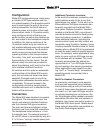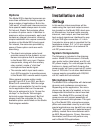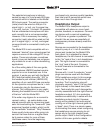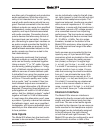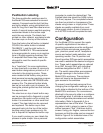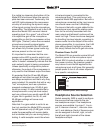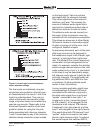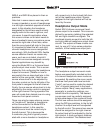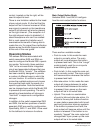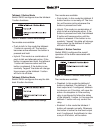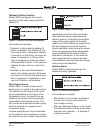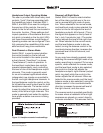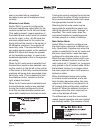
Model 233 User Guide Issue 1, September 2007
Studio Technologies, Inc. Page 19
It is visible by observing the bottom of the
Model 233’s enclosure when the security
plate has been removed. Technically, this
red LED lights whenever the compressor
circuitry is controlling the dynamic range
of the signal coming from the microphone
preamplifier. The threshold is set to be 2 dB
above the Model 233’s nominal internal
operating level. So a good “rule of thumb”
is to adjust the gain of the microphone
preamplifier so that the compressor active
LED lights (“flashes”) when the connected
microphone is sending signal peaks.
During normal operation the LED should
not remain fully lit when typical audio sig-
nals are present on the mic input.
It’s important to remember that the com-
pressor active LED is used to assist in set-
ting the mic preamplifier gain to the optimal
value. It doesn’t necessarily indicate that the
main output’s signal is being compressed.
Unless specifically configured to perform
otherwise, the output of the compressor is
only used for the talkback output functions.
It’s expected that the 20 and 60 dB gain
settings will not often be used. But there
are always exceptions and that’s why they
were included. It’s possible that with a very
“hot” microphone, such as a phantom-
powered condenser-type, 20 dB of gain
could be correct. It’s also possible that a
microphone with a very low level output,
such as a ribbon-type, would need 60 dB
of gain. But in general, the 30, 40, and
50 dB gain settings will serve most
applications.
Note that if no gain switch is set to its ac-
tive (on) position the Model 233’s preampli-
fier will operate at unity (0 dB) gain. In this
mode the preamplifier will remain stable,
but is intended only for use during factory
testing. A valid exception would be where
a line-level signal is connected to the
microphone input. This could occur with
a special Model 233 application. But with a
microphone connected as the input source
one should never use the 0 dB setting.
The issue is that with no gain added to the
microphone input signal the relative noise
floor on the circuitry associated with the
main output and talkback functions will be
much too high. These circuits are designed
for handling line-level signals, expecting to
receive audio from the output of the micro-
phone preamplifier. In conclusion, the 0 dB
gain setting doesn’t highlight a problem,
but simply reflects the unit’s gain structure.
Phantom Power On/Off
The Model 233 can provide nominal 48 volt
phantom power to the microphone input.
Switch SW1-8 controls whether or not phan-
tom power is active. By phantom power’s
very nature it could be left applied to the
microphone input at all times. But generally
people prefer to turn it off unless required
for a specific microphone.
Figure 5. Phantom power switch settings
Headphone Source Selection
Switch assembly SW2 is used to configure
the sources that are routed to the ste-
reo headphone output. Five headphone
sources are available: line input 1, line in-
put 2, intercom channel 1, intercom chan-
nel 2, and sidetone. Each of these sources
can be assigned to the left, right, or both
the left and right channels of the stereo
headphone output.



